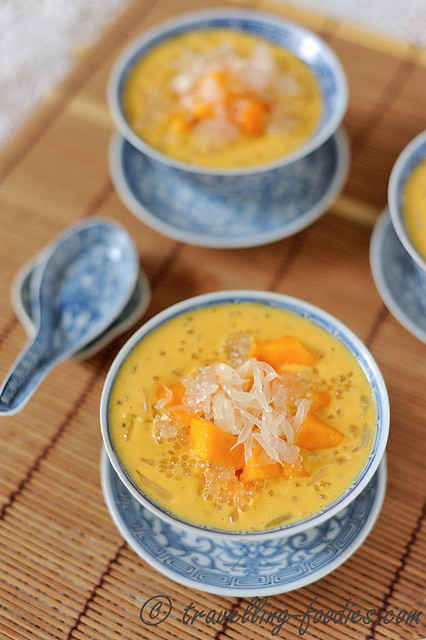Water Library Brasserie @ Central Embassy, Bangkok
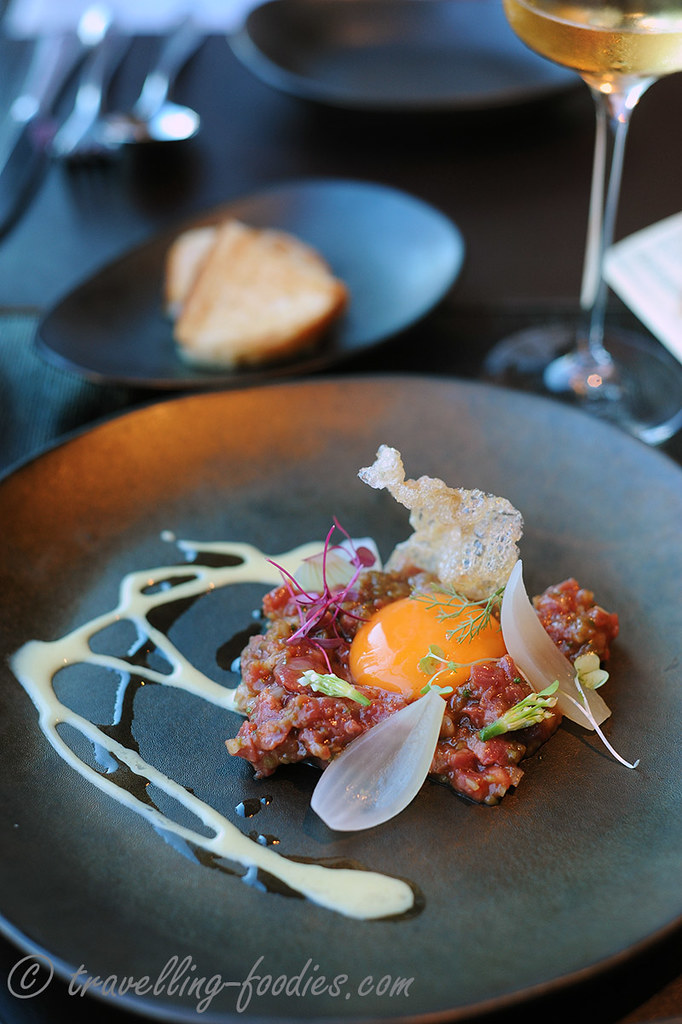
We haven’t been back to Bangkok for more than 10 years but it is not like we’d totally forgotten about it all this while as we’d booked flights and planned itineraries over the years but the trip never did materialise. We love the city but just not the social unrest which troubles the city, either from the reds or the yellows which happened from time to time. But I’m glad we finally had a chance to come back to this interesting city but seriously, we didn’t know what to expect. 10 years could change a person, lest a city. This time round, we’d decided to skip much of the usual tourist circuit of cheap shopping and street food (yes sacrilegious for Bangkok I know!) but instead, opted to experience how the city had grown and matured in other aspects of its culinary endeavors. Curious we are, but at the same time we were lost. Thankfully we have friends who frequent the city and it was not difficult to get recommendations. One place we saw popping up quite frequently on our “intel” was Water Library Brasserie @ Central Embassy.
(more…)
Tub Tim Grob – Thai Red Rubies in Coconut Milk
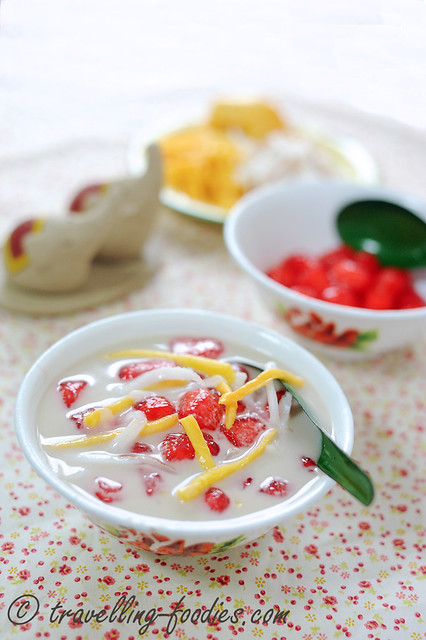
It seems like every Asian culture has their own popular sweet cold desserts which are synonymously known or associated with the cuisine. In Malaysia and Singapore, it has to be Ais Kacang and Cendol while in Hong Kong, it is 杨枝甘露 etc. Mention Thai desserts and one refreshing, yummy, not to mention visually stunning piece immediately comes to mind. Yes, it is Tub Tim Grob aka Red Rubies in Coconut Milk here.
楊枝甘露 Mango Pomelo Sago … A Revisit
How time flies and we are into the last quarter of the year already. Mid-Autumn Festival was just over a week back and I’m glad to have finally found time to make some mooncakes this year after a long hiatus for a couple of years. Thankfully this year’s mooncakes turned out alright. As I’d mentioned before in my old blog post 4 years back, I’d always looked forward to the Mid-Autumn Festival because it was always a time for family to come together and enjoy a meal. Pomelo are my favorites from this festival’s delectables, more so than mooncakes! I bought 3 large pomelos before the festival for a song and they are still sitting quietly, waiting to be pried open. And for me, there is no better way to enjoy pomelo than in the classic dessert, 楊枝甘露 Mango Pomelo Sago. (more…)
蜜瓜西米露 Honeydew Melon Sago

The heat for the past two weeks have been excruciatingly unbearable, and it most certainly doesn’t help to know that the haze is back!!! I’m down with a sore throat and some of my students are suffering from hacking coughs. Not helpful at all neighbour. Please ask your farmers to stop the burning! Mid-summer blues under the scorching weather makes one all sluggish and lethargic, not wanting to do anything except to stone in an air-con room. To make myself feel better, I’m thinking of some sugary and cooling “tong shuei” to help beat the heat. Well, I could cook a sweet 六味汤 luk mei tong or double boil some 南北杏木瓜炖雪耳 White Jelly Fungus with Papaya, or simply reprise my favorite 楊枝甘露 Mango Pomelo Sago desserts, but I’m thinking of something even simpler for instant relief. Happen to chance upon some melons at our local supermarkets just last weekend and lugged home some since they are so affordable now that they are in season. A good time to revisit one of my childhood favorites which I hadn’t eaten in eons, 蜜瓜西米露 Honeydew Melon Sago.
(more…)
On the Trail of the Phoenix – Bubur Cha Cha Durian
Bubur Cha Cha or “Bubor Cha Cheir” as it is known to some Peranakans, is a dessert soup which comes close to heart for my family. My mum loved it immensely and made it often enough for us to develop a liking for it as well since young. It is a chuchi mulot which she would exercise her creativity in the ingredients to be added depending on the amount of time she had at hand and of course what we loved to eat. Kept minimalistic, it would simply be just a sweet coconut milk broth base with diced kledek (sweet potato) and keladi (taro) cooked in it. More elaborated, an assortment of other “accessories” like bijik sagu kechik (small sago pearls), and legumes like kacang merah (red beans), kacang ijo (green beans) or kacang mata itam (black-eyed peas) can be cooked separated and added. Our favorite condiment must surely be sagu gunting, chewy morsels made from either sago flour or tapioca flour that look like gems sparkling in a pool of ingredients coated with a riot of psychedelic colours. Sometimes fruits will be added, mostly pisang (bananas), occasionally nangka (jackfruit) or even cempedak, and of course whenever it is in season, durian!
(more…)
On the Trail of the Phoenix – Sago Gula Melaka
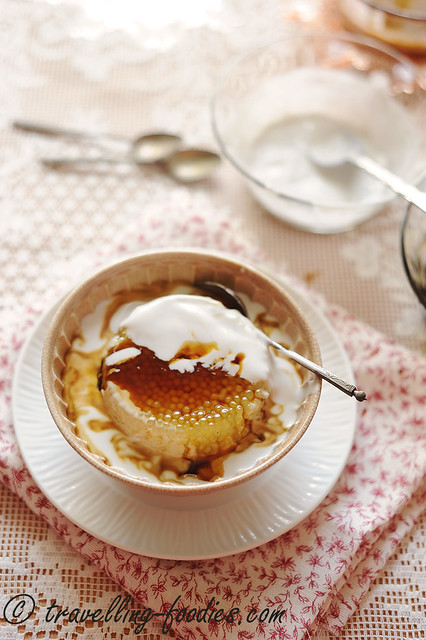
The weather has been somewhat erratic and unforgiving of late, tormentous heat wave for the last 2 weeks or so making the days go by in an utmost unbearable manner and then came the torrential rain yesterday afternoon. Despite the downpour, the cool-down it provided was only short-lived and temporal as it is back to another stuffy and hazy day. In need of something cold and refreshing, I made another favorite Peranakan chuchi mulot of mine for some instant relief. Looks like I’m on a dessert making spree! Sago Gula Melaka is incredulously easy to prepare and can be made way ahead. Just barely 30 min of work last night before going to bed and I’m ready to indulge in all that santan and gula melaka goodness this afternoon!
(more…)
On the Trail of the Phoenix – Pengat Pisang

Peranakan cuisine is well-known for its assortment of kuehs and sweet dishes, otherwise known as “chuchi mulot“. Most appropriately known as “palate cleansers” as many of these desserts, packed with much of their rich and sugary goodness break the monotony of the earlier main course dishes which are already imbued with much piquant flavours in spicy, savory and tang. The balance they provide brings about much contrast to the earlier dishes in a meal, and at the same time adding more experiential dimension and depth to the overall palate sensation, not to mention a resounding conclusion to an often hearty meal.
Bubor Cha Cha, Chendol and Pulot Itam, just to name a few, are some of the favorite chuchi mulots around, but my absolute “to cook the soonest and enjoy the fastest” so as to to curb that sweet tooth craving, has to be Pengat Pisang.
(more…)
Apom Berkuah… A Pictorial Guide
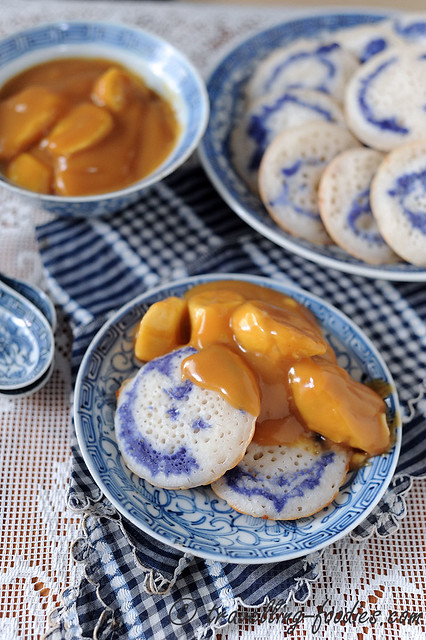
Apom Berkuah is one of my favorite kuehs and I try to make it whenever time avails. Despite being a Peranakan signature “cuchi mulot“, I believe that it has its roots in Indonesian cuisine where it is known by another name Kue Serabi, and variations likening surabi or srabi. Even amongst Peranakan communities in Singapore, Malacca and Penang, the pronunciation also differ slightly from Apom Berkuah, to Apom Bokwa and Apom Bengkua. To the Malays from Kedah, Malacca and Sabah, it is called “Kuih Serabai“,with a slightly phonological shift in the terminal syllable, where it transits to become a diphthong in place of the short monophthongal vowel, a linguistic nuance we commonly observe across many Bahasa Melayu to Baba Patois lexicographical pairs. The word “Apom” which was derived from “appam“, a south Indian pancake popular in Kerala and Tamilnadu, is sometimes spelt as “apong” instead. Despite the numerous names, one thing remains the same for this kueh, and that is how delicious they are! So let’s see how we make them!
(more…)
九份芋圓 – Jiu Fen Taro Balls
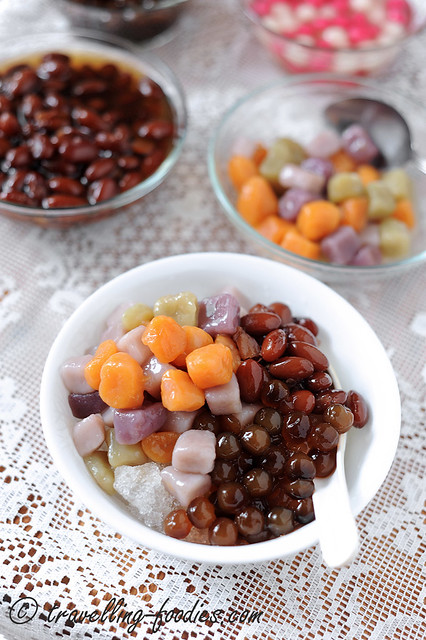
九份 Jiu Fen (or sometimes scripted as “Jiou Fen“) is a small township perched on the hilly terrains of north-eastern Taiwan. Together with 金瓜石 Jin Gua Shi, 十分 Shi Fen, 瑞芳 Rui Fang and 金山 Jin Shan, Jiu Fen was an important gold mining area more than a century ago. But as the yield decreased over time, the mining activity dwindled and eventually came to a halt. The town quieten down and became mostly forgotten for more than a decade, until 《悲情城市》, a movie set in Jiu Fen by renowned Taiwanese director 侯孝贤 Hou Hsiao-Hsien brought to it the curious crowd from Taipei and other parts of the island state. Even then, more than 20 years has since passed and even 《悲情城市》 too has become forgotten. But the movie left behind for Jiu Fen a tourism legacy. Till today, the small town is packed with local visitors and foreign tourists every weekend. Folks flock here for the fresh mountain air, the scenie view of Keelung Fishery Port and of course, a wide selection of local delights which Jiu Fen is well known for, including草仔粿 mugwort glutinous rice cakes from 阿蘭草仔粿, 鳳梨酥 pineapple cakes from 李儀餅店 and of course the infamous 九份芋圓 Jiu Fen Taro Balls.
(more…)
Mikimoto Lounge @ Ginza, Tokyo
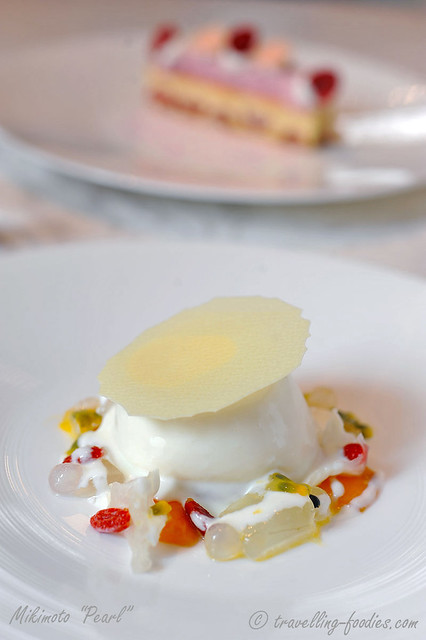
Speak of Japanese pearls and one would immediately think of Mikimoto, whose propelled the technology of pearl culture in Japan more than 120 years ago, that eventually propelled to become the multi-million dollar business empire we know today. Mikimoto pearls are still much sort after and highly regarded in the industry for their quality. We told ourselves that we must make it a point to visit the Mikimoto Ginza 2 building when we visit Tokyo. But it is not the pearls that we are after. Not the real ones at least, but instead the plated desserts at the Mikimoto Lounge located within!
(more…)
On the Trail of the Phoenix – Kueh Ee & Tang Chek

For the Chinese in the past, the Winter Solstice marks the arrival of winter proper, falling on either 21st or 22nd of December every year. It is an important day in the lunar calendar and for some, even more so than Chinese New Year itself. Despite being in the tropical Malay Archipelago which knows no seasons, Peranakans from the region stretching from Thailand, to Malaysia, Singapore and all the way down to Indonesia celebrate this important day as “Tang Chek” (“冬至” in Hokkien) with worship and good food. Tang Chek also marks the beginning of a two-month long process of preparatory work which leads up to Chinese New Year (Taon Baru Cina) itself, ending the festivities on Chap Goh Meh (“十五眠” in Hokkien) which mean literally the 15th day of the 1st lunar month.
Homemade Middle Eastern Pomegranate Molasses

Apart from being defined by discernible differences in taste and textures, many cuisines are also distinguishable by looking into the ingredients and condiments used in their recipes. Miso is uniquely Japanese just as one would associate oyster sauce with Chinese cooking. Mention fish sauce and one immediately relates it to Thai and Indochinese cuisines. Middle Eastern cuisines, be it Arabian, Jewish, Turkish or Persian also have their own special range of ingredients. Turkish apricots and figs, Iranian pistachios, rose water, sumac etc… are just some of the things that reminds me of this group of cuisines which have influenced the structuring and development of one another for centuries. And just as with the sauces and pastes I’d mentioned earlier, Middle Eastern cuisines too have their own unique concoctions adopted to boost the rich and piquant flavours many dishes from this region are well-known for. Pomegranate molasses must surely be one of them.
姜汁撞奶 Ginger Milk Pudding
We love to have desserts whenever we are in Hong Kong. The Cantonese folks are very much dessert lovers like us, and they are extremely well-known for their assortment of 糖水 “tong shueis” which are both delicious and therapeutic at the same time. The desserts are available all year around, with a menu that changes with the seasons. Summer welcomes the ice blends and chilled items, most notably being 楊枝甘露 Mango Pomelo Sago which is immensely popular especially with the young to combat the heat. For those who are looking for more traditional desserts, there is 南北杏木瓜炖雪耳 Double-boiled White Jelly Fungus with Papaya which is not only sweet, but boast to have a hoard of beneficial properties like soothing the throat and clearing phlegm. As the weather turns cold, the hot desserts become immensely popular, be it the “paste-based” desserts like 芝麻糊 sesame paste, 花生糊 peanut paste, 核桃糊 walnut paste, 杏仁糊 almond paste or even a simple bowl of 番薯姜汤 ginger soup and sweet potatoes with 汤圆 glutinous rice dumplings to warm the tummy.
As such, dessert parlours and tong shuei stalls are found literally everywhere in Hong Kong. Strange it may sound however, one of the places to enjoy these sweet numbers is not at dessert joints like 許留山 Hui Lau San and 大良八記 Dai Leung Pak Kee, but at 牛奶公司 “dairy companies”. And to further bewilder the already perplexed, these “dairy companies” do not produce milk but are actually tea shops or cafes affectionately known to the locals as 茶餐厅 “cha tzan teng“. Now are you confused already?
(more…)
品悅糖 Pâtisserie La Douceur @ Taipei … a revisit
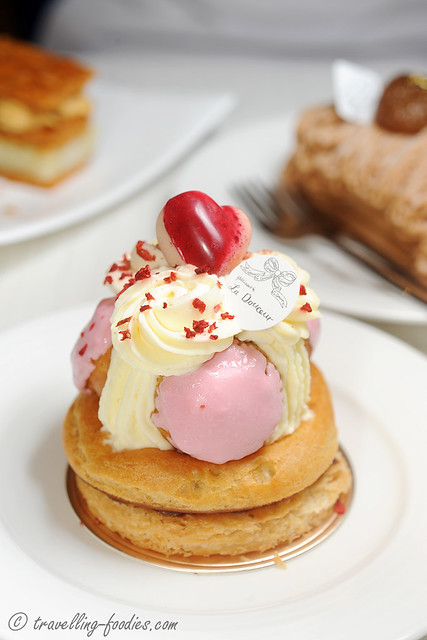
Yes we are back here again! We’d visited them back in 2011 and were quite impressed with their creations then. Hence, we’d decided to come back again on our next trip to Taipei. Found out through a fellow blogger Chelle that their selection changes periodically. Well, we kinda figured that out as what she sampled looked entirely different from what we’d tried!
(more…)
Gâteau de Tangelo Pochées

Gâteau de Tangelo Pochées or Poached Tangelo Cake, is a very simple to make flourless and butterless cake with an incredible citrusy zing to it. No gluten, almost fat-free, and potentially low sugar, this gateau makes the perfect afternoon tea cake, allowing one to indulge so ever frequently in an almost guilt-free manner and yet not become bored of it, as the flexibility of the recipe allows to be to readily modified for other citrus fruits varieties and even other fruits. The original recipe was for “Gâteau de clémentines pochées” (Poached Clementine Cake) in Trish Deseine‘s book “Mes Petits Plats Préférés“, a collection of simple-to-follow, and almost dummy-proof recipes which helped her to win the French Gourmand Cookbook Award in 2002. Exactly 10 years later now her recipes proved to be ever-withstanding and easily reproducible. Deseine used clementines for her cake, a variety of mandarin oranges known for their seedless qualities. But since tangelos are in season, I’d used them instead, and may I add that the result was simply delish!
